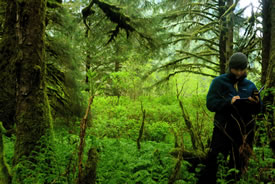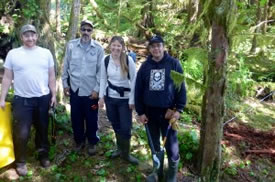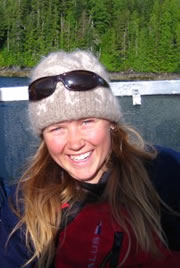Doing Science that Matters: Engaging with Communities in Collaborative Scientific Research

University of Victoria student Megan Adams monitoring hair snags near Wuikinuxv Village, BC (Photo by ACS lab)
I should have known I would become an ecologist. As a child, I always seemed to catch a salamander while waiting for the school bus, or bring home precious flowers to press through the seasons. I could stare from the bus window out into the grasslands, which transitioned into foothills to give rise to the Rocky Mountains, and imagine infinite ecosystems beyond. My passion as a naturalist and ecologist flourished as a biology undergraduate on the coast of British Columbia, Canada.
But beyond wondering wide-eyed at the complex co-evolved relationships in predator-prey systems or doggedly trying to grasp phylogenetic trees of fishes and or plants in my coursework, I was always drawn to science that mattered.
Of course, all science matters. I suppose I mean science that matters to people who aren’t necessarily western-trained scientists. Science that guides management of natural resources, focuses conservation efforts, and informs policy. I found myself taking summer research internships on projects that coupled elegant scientific methods with socio-economic issues — fisheries pathology as impacted by industrial aquaculture, carnivore monitoring in the face of habitat loss or invasive species’ impacts in vulnerable and culturally significant ecosystems.
Science beyond the walls of the academy
More often that not, our research teams would seek the advice of people who lived in communities where the study was taking place. In the context of coastal British Columbia, these communities may be indigenous or non-indigenous and are made up of people with long-standing, adaptive, and evolving knowledge of natural systems. Local folks would often be part of the research teams, teaching us about prevailing weather patterns and sharing ecological insights on the species we were studying. Scientists were supporting communities with their expertise, but the local knowledge and on-the-ground capacity communities shared with the research teams was just as striking. This was science guided by place-based knowledge and local context— science beyond the walls of the academy.
These experiences provided the foundation for my graduate research, where I study coastal carnivore populations as part of a dynamic team made up of academic and community scientists from the Wuikinuxv, Kitasoo/Xai’Xais, Nuxalk and Heiltsuk Nations, in whose territories we work.

The crew of technicians from the Wuikinuxv Coastal Guardian Watchmen and the Raincoast Conservation Foundation finishing up at a non-invasive bear hair sampling station in Wuikinuxv territory, BC (Photo courtesy of Megan Adams)
Collaboration = Communication
In our experience, truly engaging with community partners means collaborating right from the onset of the research process. As academics and community members, we work towards a common research focus, develop research questions and hypotheses, conduct fieldwork with collaborative teams and are transparent about where, when and how findings are communicated. Our team articulated our thoughts on ecological research and engagement in a recent publication, but like many things, it is easier to write about than to practice day-to-day.
I will not pretend an engaged research process comes without its challenges. While community members may also be scientists (and vice versa), team members may have different ways of knowing and different methods of inquiry. Western science and place-based knowledge come from very different approaches, although they may converge on similar observations and findings. Cultural differences may exist among team members, and in the indigenous context this is amplified by past and present colonial violence and oppression against indigenous peoples.
Navigating these challenges depends on building strong and transparent relationships, which requires humble and open communication, as well as additional funding and time for extended field seasons and visits during the “off-season.” These are important components that can enable and support the space required for relationship building — for moments like eating and feasting together, sharing in celebration and/or ceremonies or youth outreach — none of which are directly related to research (at least at first glance). More often than not, it has been during conversations in the local restaurant over a cup of coffee, a chat down at the wharf, or a walk to the river with the school kids that have I have found space to overcome these challenges. These are the times where I have begun learning to listen.
It is a very vulnerable thing to collaborate in the research process; stepping outside the bounds of our academic institutions can be hard. It isn’t something we are always taught as scientists. And yet, now that I am part of a community-engaged research program, I cannot imagine doing science any other way. Our science is enriched by local knowledge and has the potential to inform policy and conservation. We have personal and professional relationships with local collaborators, which further develop as our trust in each other grows. Deep down, I am still that nature-captivated child, but now I am learning and sharing and laughing with the people who are just as much a part of the landscape as the salamanders, the fish, and the bears.
This post originally appeared on the Union of Concerned Scientists‘ blog, The Equation.


